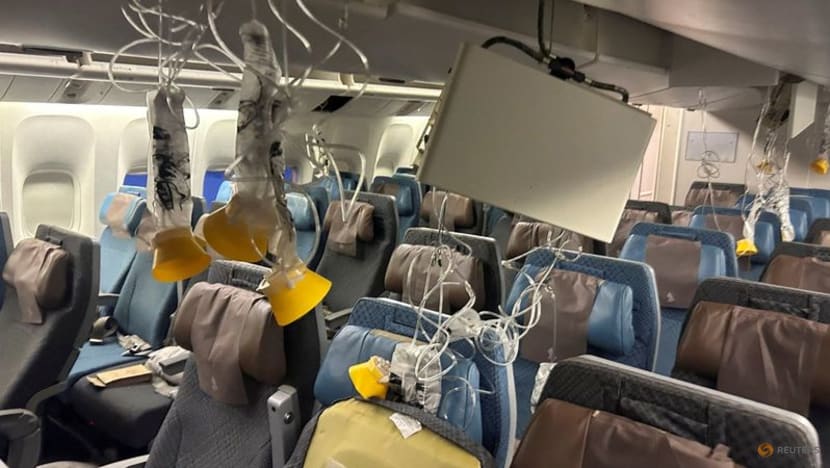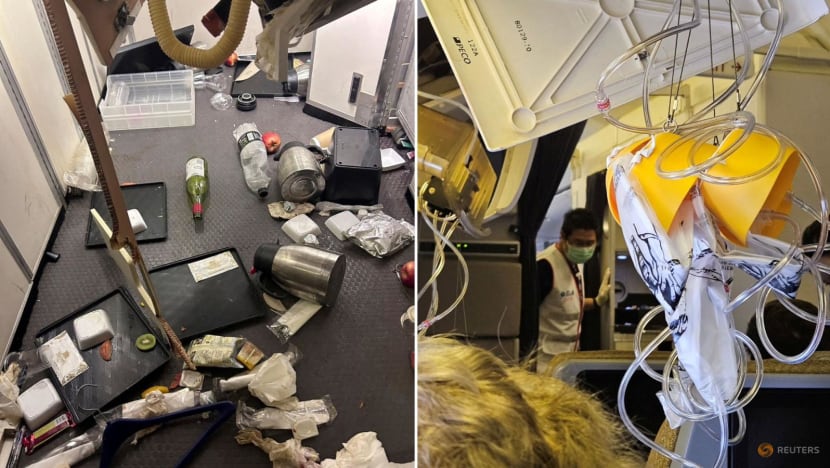SQ321 turbulence: Components of plane's weather radar system sent for tests in US

The interior of Singapore Airlines flight SQ321 after it encountered severe turbulence and was forced to make an emergency landing at Bangkok's Suvarnabhumi International Airport, Thailand, May 21, 2024. (Photo: Reuters/Stringer)

This audio is generated by an AI tool.
SINGAPORE: Components of the weather radar system in the Singapore Airlines (SIA) plane that was hit by severe turbulence in May 2024 have been sent to the United States for examination and tests, Singapore's Transport Safety Investigation Bureau (TSIB) said on Tuesday (May 27).
"The component examination and test report detailing the findings is still pending," the bureau said, adding that it would make public the final report upon completion of the investigation.
SIA flight SQ321 had been flying from London to Singapore on May 21, 2024, when it encountered severe turbulence over the south of Myanmar at 37,000 feet.
One passenger died on board while 79 others suffered injuries. The plane was diverted to Bangkok.
"Investigations by Singapore’s TSIB are ongoing, and conducted in accordance with the International Civil Aviation Organization’s (ICAO) requirements," TSIB said on Tuesday.
"The TSIB is assisted by investigators from the National Transportation Safety Board (NTSB) and Federal Aviation Administration (FAA) and is supported by Boeing as well as other stakeholders."
The TSIB comes under the Ministry of Transport (MOT).
Using flight data, investigators reconstructed what happened on Singapore Airlines flight SQ321 when it hit severe turbulence over the south of Myanmar on the way from London to Singapore on May 21. A passenger died and dozens more were injured, resulting in an emergency diversion of the plane to Bangkok.
MOT said in May last year that preliminary investigations showed that "rapid" changes in gravitational force and an altitude drop likely caused injuries to passengers and crew members who were not belted up.
British national Geoff Kitchen, 73, died in the incident. His death was likely due to a heart attack, Suvarnabhumi Airport general manager Kittipong Kittikachorn had told a press conference.
Others were slammed into the ceiling, causing head and spinal injuries.
Photographs of the interior of the plane after the incident showed oxygen masks and panels hanging from the ceiling and hand luggage strewn around.

In June last year, SIA apologised for the incident and said it would offer monetary compensation to the 211 passengers.
Those who sustained minor injuries from the incident were offered US$10,000 (S$12,866) in compensation.
Passengers who suffered more serious injuries were "invited ... to discuss a compensation offer to meet each of their specific circumstances".
In response to CNA's queries on Tuesday, an SIA spokesperson said that the airline continues to cooperate fully with the relevant authorities in investigations and is committed to providing the necessary support and assistance to affected passengers.
"Following the incident, SIA sent compensation offers directly to the passengers on Jun 10, 2024. While some passengers have accepted these offers, we continue to engage with the others directly or via their appointed representatives," the spokesperson said.
"We regret that we are unable to provide more details due to confidentiality reasons."













